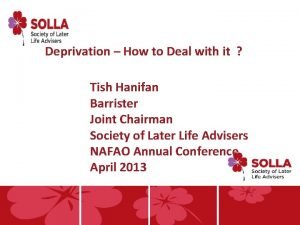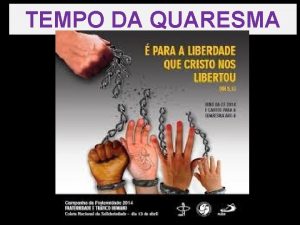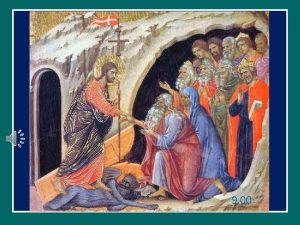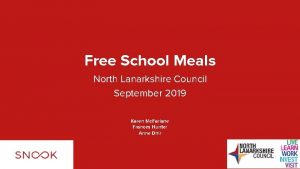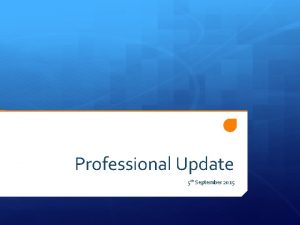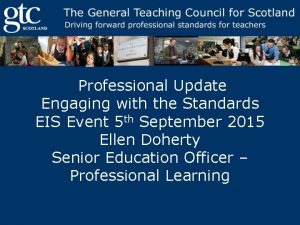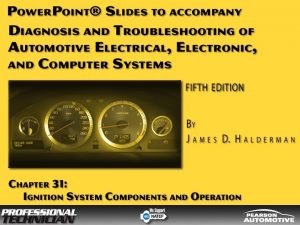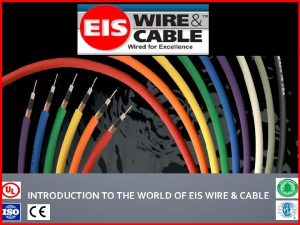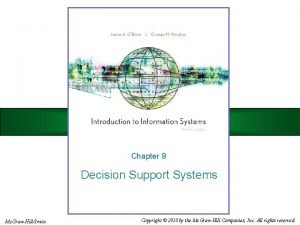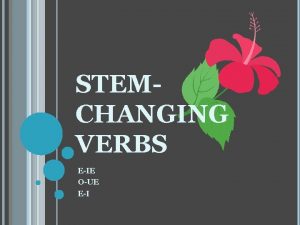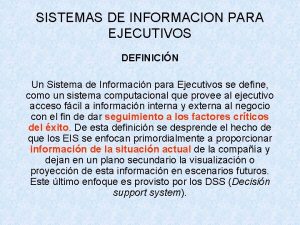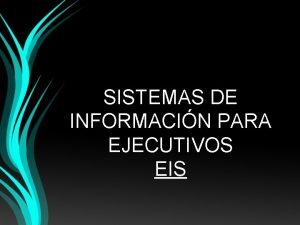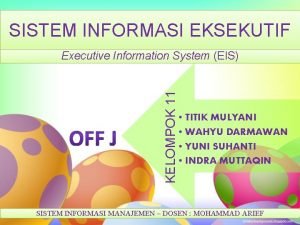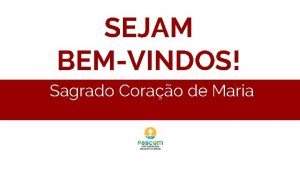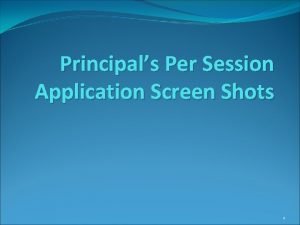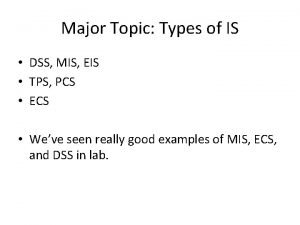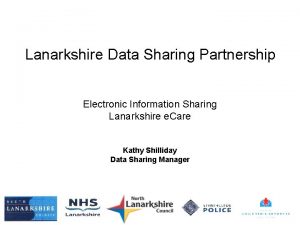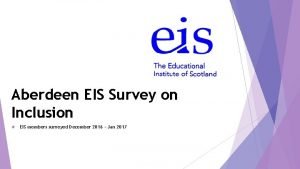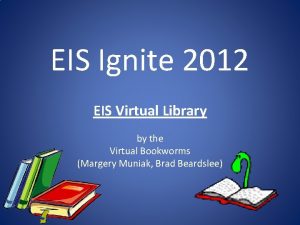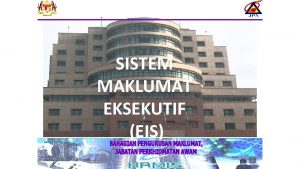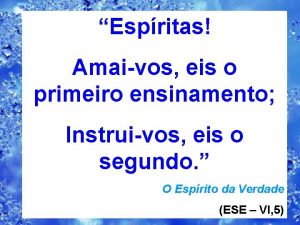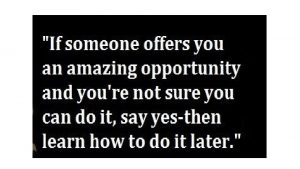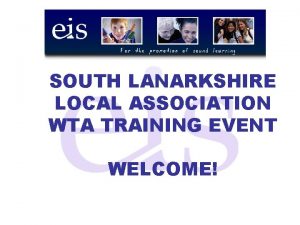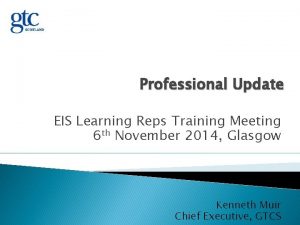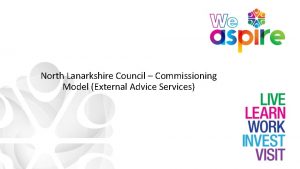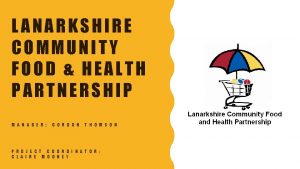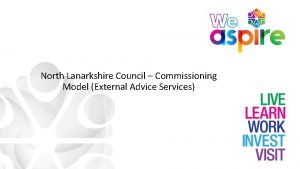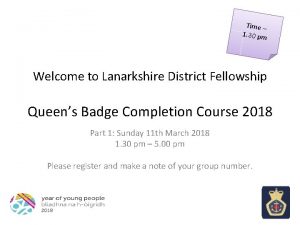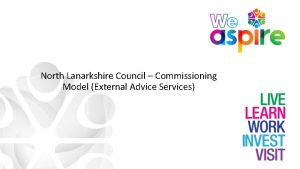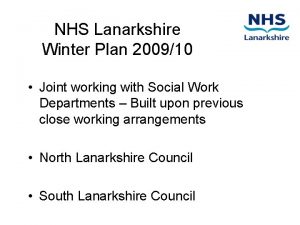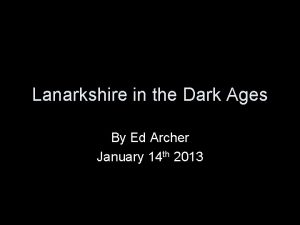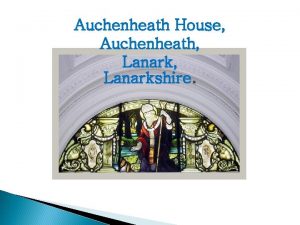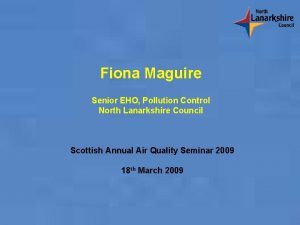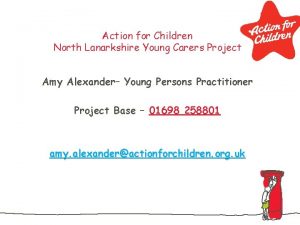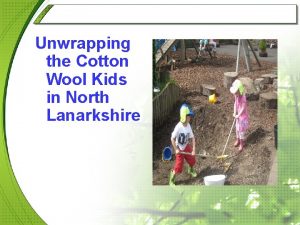Professional Update and Evidence EIS and South Lanarkshire































- Slides: 31

Professional Update and Evidence EIS and South Lanarkshire Council 5 September 2015 Tom Hamilton GTC Scotland #gtcs. PL #gtcs. PU

What is Professional Update? Key purposes: • To maintain and improve the quality of our teachers as outlined in the relevant Professional Standards and to enhance the impact that they have on pupils’ learning. • To support, maintain and enhance teachers’ continued professionalism and the reputation of the teaching profession in Scotland.

Key principles of Professional Update: Teachers will. . . • have a responsibility to consider their own development needs • have an entitlement to a system of supportive PRD • be able to confirm that they are maintaining the high standards required of a teacher

What do you need to do? The key features of PU • On – – – an ongoing basis: engage in the staff review (PRD) scheme engage in ongoing professional learning maintain a reflective record of PL and evidence of impact on thinking and actions – reflect and plan using the Standards • On an annual basis: update registration details • On a 5 -yearly basis: sign off to confirm engagement in the process every 5 years with GTC Scotland (teacher and line manager)

6 features of effective PRD • • • Entitlement & responsibility of all as part of commitment to PL Positive impact on planning & engagement in PL and practice within ethos of collegiality Ongoing process that is supportive & challenging Founded on robust, evidence-based self-evaluation Focused professional dialogue, based on coaching approaches Maintained reflective record of PL and associated evidence of impact NB: competence has separate procedures from PU

Professional Update Pilot Phase 2: Final Evaluation April 2015 Key issues: • knowledge, understanding and skill level of the reviewer; • the distinctive nature of the PRD process as part of Professional Update; • using evidence of impact; • depth of knowledge of the Standards; • consistency and rigour of the PRD process; • technical systems in place to facilitate recording of PL and PRDs.

Knowledge, understanding and skill level of the reviewer Reviewers appeared knowledgeable and confident with the main processes and procedural requirements of Professional Update. However, of particular concern was their knowledge and confidence in some of the more complex and deeper aspects of PU, particularly: • skill, ability and confidence in adopting coaching and mentoring approaches; • ability to appropriately challenge and develop meaningful dialogue around evidence of impact.

The distinctive nature of the PRD process as part of Professional Update The nature of PRD has changed as part of the PU process and whilst this has been broadly recognised it has not been fully embraced or embedded into practice. Issues were raised regarding the time constraints that limit the opportunities for developing meaningful ongoing dialogue as part of PRD. Of more concern is the perceived value of the process by a minority. This creates an inequity in terms of opportunity for reviewees across the profession but of more concern is the possible impact of the process becoming a bureaucratic tick box exercise that is more concerned with ‘form filling’ rather than deep, meaningful engagement about professional learning and its impact on practice for the benefit of learners across the education system.

Using evidence of impact Using and reflecting on evidence of impact of professional learning is an important part of the PU process. This is clearly an area where all involved are still developing their own understanding of what this may look like and what it means in practice. It also requires challenging some previous practices and long-held beliefs about what ‘evidence’ is. Particular areas of issue that emerged related to: • • • individual’s skills of analysis and possible approaches to evaluating professional learning and ascertaining its impact; knowledge and understanding of what might count as evidence; reviewer’s ability to offer appropriate challenge by asking questions about evidence and a reviewee’s claim about impact; time for reviewees to reflect in appropriate depth about their professional learning and its impact and opportunities to consider this on an on-going basis; the need for more advice and guidance in this area.

Depth of knowledge of the Standards Whilst there has been a positive increase in engagement with, and perceived value of, the usefulness of the Standards there remains a perception that deeper engagement is required.

Consistency and rigour of the PRD process Related to individual reviewer’s knowledge, understanding and skill of PU and the PRD process has meant that some reviewees are experiencing a less rigorous and meaningful PRD process, which is limiting their opportunity for engagement and quality professional review and development.

Evaluation of Year 1 of national roll-out • 85. 3% of respondents found the Professional Standards useful ‘to a large extent/some extent’. • 29. 9% of respondents found their PRD meeting very useful and 54. 4% useful, in helping to reflect on their previous year’s PL, its impact and to plan their learning for the coming year. (Concerns were around engagement and capacity of the reviewer to facilitate the PU process. ) • 83. 9% of respondents felt there was about the right balance in their PRD meeting between support and challenge • Some teachers commented that their PRD meeting was now more reflective and focussed, one respondent stating that their PRD had “clearly focussed now on Professional Standards, impact and evidence”. • 91. 2% of respondents felt they had ownership and responsibility for their PRD and PU process ‘to a large extent/some extent’.

Professional Learning and evidence of impact • Collaborative learning was considered the most valuable Professional Learning activity. • Respondents were very positive in how their Professional Learning has been relevant to and impacted on their practice. • The majority of respondents felt they had ownership of their Professional Learning.

Relevance, Impact and Ownership of Professional Learning 209 My professional learning has challenged my thinking and practice this year 278 48 10 My professional learning has been relevant to my development needs this year 306 207 28 4 324 I have had ownership over the professional learning I have engaged in 188 26 7 To a large extent To some extent Not very much Not at all

Preparing for my PRD. . . • What do you view as the purpose of your PRD? • What do you hope to get from your PRD? • What do you need to do to make this happen?

The PRD dialogue How has my PL deepened my knowledge and developed my practice? What changes in my practice this year? How do I know?

Features of robust self evaluation. . . It involves: • Asking deep and searching questions about your knowledge, understanding skills and professional practice • Using the GTCS Standards to inform and guide your reflections • Using other influencing factors, such as School/Dept Improvement Plan; HEA • Evidence from your practice should inform and support your self evaluation Self evaluation should enable you to: • Identify strengths and areas for development • Focus on areas for developing expertise • Plan your PL • Consider career planning Self evaluation as part of PRD within the PU process is not about proving competence against each aspect of the Standard; showing you ‘meet’ the Standard or addressing every element within a fixed period of time.

What Teachers said about the Standards The Standards are a useful starting point for exploring my development needs by helping me identify the areas I should target as a priority. I can then decide whether personal reading and research would be most helpful, whether I need advice from colleagues, whether I need to apply for a course or ask to work with/observe someone with proven expertise in that area or seek advice from my mentor. Engaging with the Standards has ensured that I actually do what I intend to do. I now take time to self-evaluate and carefully plan in the light of being involved in the pilot year. This has been good for me and undoubtedly the young people I teach.

Where can I get support materials for the Standards? Online Standards Support Materials: www. gtcs. org. uk

Professional Learning Process

Some important starting points about Professional Learning. . . A model of Professional Learning:

The Professional Learning Process

Thinking about the impact of your Professional Learning. . . • Impact on: – you, your thinking & practice – your colleagues, your learners, the system, etc • Evidence should be: – – drawn from range of sources Relevant & meaningful analysed and reflected on Key messages shared as part of professional dialogue • Evidence helps to make explicit the processes of thinking and learning about practice

Examples of evidence • Reflections on professional dialogue with peers, parents, colleagues and learners • Individual critical reflections on practice, including reflective journals • Analysis of pupil work, individual or group focused • Analysed teacher talk (from audio and/ or video recording) • Analysed pupil talk (individual, group and pair) • Analysis of surveys taking account the views of children and young people, parents and colleagues • Reflection on and analysis of lessons and/ or discussions with learners • Analysis of visual data, artefacts • Analysed pupil interviews/ group discussion • Analysed quantitative or statistical data sets

What it’s not:

Evidence of impact should: • help you develop knowledge and understanding of practice and pupils' learning; • be about a genuine reflection and analysis of your thinking, practice and professional actions; • help you think about your learning, your practice and pupil learning. A key part of this process is asking: "What have I learned? “ • move from tacit reflections to a more explicit analytical process. ; • shift from being reactive to a more proactive approach to PL; • possibly focus on a one or two critical incidents as part of your learning process? 'Critical Incidents in teaching' by David Tripp (2012) is available as an e. Book via My. GTCS. See also Education Scotland: Evidence of Impact: http: //www. educationscotland. gov. uk/professionallearning/clpl/evidence. asp

From data to evidence: the importance of analysis Evidence should come from a wide range of sources and does not always need to be a written record. Data is everywhere but for it to be evidence it must: • • • Be relevant and meaningful for your purposes. What is it you need to know? Why is the most useful/meaningful source of information for you? Ask the 'right' questions of the data and being critical. Be analysed and reflected on. What does the data tell you? What does that mean for you and your practice? How does it relate to other knowledge/ information (policy, other practice, literature, research) 'Putting together Professional Portfolios' by Christine Forde, Margery Mc. Mahon and Jenny Reeves (2009) available as an e. Book via My. GTCS.

Models for the evaluation of teachers’ professional learning - including involvement in research? Kirkpatrick (1998) Guskey (2000) five levels: 1. participants’ reactions; 2. participants’ learning; 3. the use of new knowledge and skills; 4. student outcomes; 5. organisational support and change.

Where can I get more information about Professional Update? www. gtcs. org. uk

Scientific American 15 July, 2014: Scientists Bring New Rigor to Education Researchers are using tools borrowed from medicine and economics to figure out what works best in the classroom. But the results aren't making it into schools Anna Fisher was leading an undergraduate seminar on the subject of attention and distractibility in young children when she noticed that the walls of her classroom were bare. That got her thinking about kindergarten classrooms, which are typically decorated with cheerful posters, multicolored maps, charts and artwork. What effect, she wondered, does all that visual stimulation have on children, who are far more susceptible to distraction than her students at Carnegie Mellon University? Do the decorations affect youngsters' ability to learn? To find out, Fisher's graduate student Karrie Godwin designed an experiment involving kindergartners at Carnegie Mellon's Children's School, a campus laboratory school. Two groups of 12 kindergartners sat in a room that was alternately decorated with Godwin's purchases or stripped bare and listened to three stories about science in each setting. Researchers videotaped the students and later noted how much each child was paying attention. At the end of the reading, the children were asked questions about what they had heard. Those in the bare classroom were more likely to pay attention and scored higher on comprehension tests.

Getting in touch E-mail: Professional-Update@gtcs. org. uk Web: www. gtcs. org. uk/professional-update Twitter: #gtcs. PU #gtcs. PL
 Yule v south lanarkshire council
Yule v south lanarkshire council Eu te peço que tu me convertas o coração
Eu te peço que tu me convertas o coração Requiem aeternam dona ei domine
Requiem aeternam dona ei domine Deferred update and immediate update
Deferred update and immediate update North lanarkshire school meals
North lanarkshire school meals Gtcs professional update examples
Gtcs professional update examples Gtcs spr
Gtcs spr Individual evidence can have probative value
Individual evidence can have probative value Old south vs new south streetcar named desire
Old south vs new south streetcar named desire Primary evidence vs secondary evidence
Primary evidence vs secondary evidence Primary evidence vs secondary evidence
Primary evidence vs secondary evidence Secondary sources
Secondary sources Primary evidence vs secondary evidence
Primary evidence vs secondary evidence Jobs vancouver
Jobs vancouver Is fiber class evidence
Is fiber class evidence Class evidence vs individual evidence
Class evidence vs individual evidence Class vs individual evidence
Class vs individual evidence Ecological fallacy
Ecological fallacy Coil polarity is determined by the ________.
Coil polarity is determined by the ________. Hei and eis are examples of
Hei and eis are examples of Eis wire and cable
Eis wire and cable A is a web based interface and integration of mis dss eis
A is a web based interface and integration of mis dss eis Eis pay scale
Eis pay scale Nada bes enharmonis dengan nada
Nada bes enharmonis dengan nada E-i verbs
E-i verbs Sistemas de informacion para ejecutivos
Sistemas de informacion para ejecutivos Sistemas eis
Sistemas eis Apa itu executive information system
Apa itu executive information system Uma voz do céu ressoa
Uma voz do céu ressoa Per session form
Per session form Mis eis
Mis eis Eis modell bruner
Eis modell bruner
